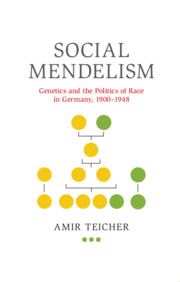Book contents
- Social Mendelism
- Social Mendelism
- Copyright page
- Dedication
- Epigraph
- Contents
- Figures
- Acknowledgments
- Abbreviations
- Introduction
- 1 Mendel’s Laws and Their Application to Humans, 1865–1913
- 2 Mendelism Maturing: From Experimental to Interpretative Framework, 1913–1933
- 3 Mendelism, Purity and National Renewal
- 4 Annihilating Defective Genes: Mendelian Consciousness and the Sterilization Campaign
- 5 Mendelizing Racial Antisemitism
- Epilogue: Social Mendelism beyond the Nazis
- Bibliography
- Index
1 - Mendel’s Laws and Their Application to Humans, 1865–1913
Published online by Cambridge University Press: 03 February 2020
- Social Mendelism
- Social Mendelism
- Copyright page
- Dedication
- Epigraph
- Contents
- Figures
- Acknowledgments
- Abbreviations
- Introduction
- 1 Mendel’s Laws and Their Application to Humans, 1865–1913
- 2 Mendelism Maturing: From Experimental to Interpretative Framework, 1913–1933
- 3 Mendelism, Purity and National Renewal
- 4 Annihilating Defective Genes: Mendelian Consciousness and the Sterilization Campaign
- 5 Mendelizing Racial Antisemitism
- Epilogue: Social Mendelism beyond the Nazis
- Bibliography
- Index
Summary
Mendel did not formulate his findings in the form of a series of laws. This task was left to his followers, who formulated the rules of Mendelian theory in a variety of ways. Following the successful application of Mendelian principles in plant and animal breeding experiments, anthropologists, psychiatrists and genealogists attempted to identify Mendelian patterns also in man. The two scientists who tried most rigorously to introduce Mendelian concepts into their respective fields in the early 1910s – Eugen Fischer (in anthropology) and Ernst Rüdin (in psychiatry) – would later become among the most prominent scientists in the Nazi academic world. Fischer’s work on racial bastardization (hybridization) signaled the path that racial anthropology was to take in future years; Rüdin’s treatise on the Mendelian nature of mental illnesses proved pivotal in shaping later psychiatric thinking. Genealogists tried to similarly devise a genealogical chart that would accord with Mendelian requirements. By the eve of WWI, physical anthropology, psychiatry and genealogy all seemed on the verge of a new Mendelian era.
Keywords
- Type
- Chapter
- Information
- Social MendelismGenetics and the Politics of Race in Germany, 1900–1948, pp. 22 - 53Publisher: Cambridge University PressPrint publication year: 2020



